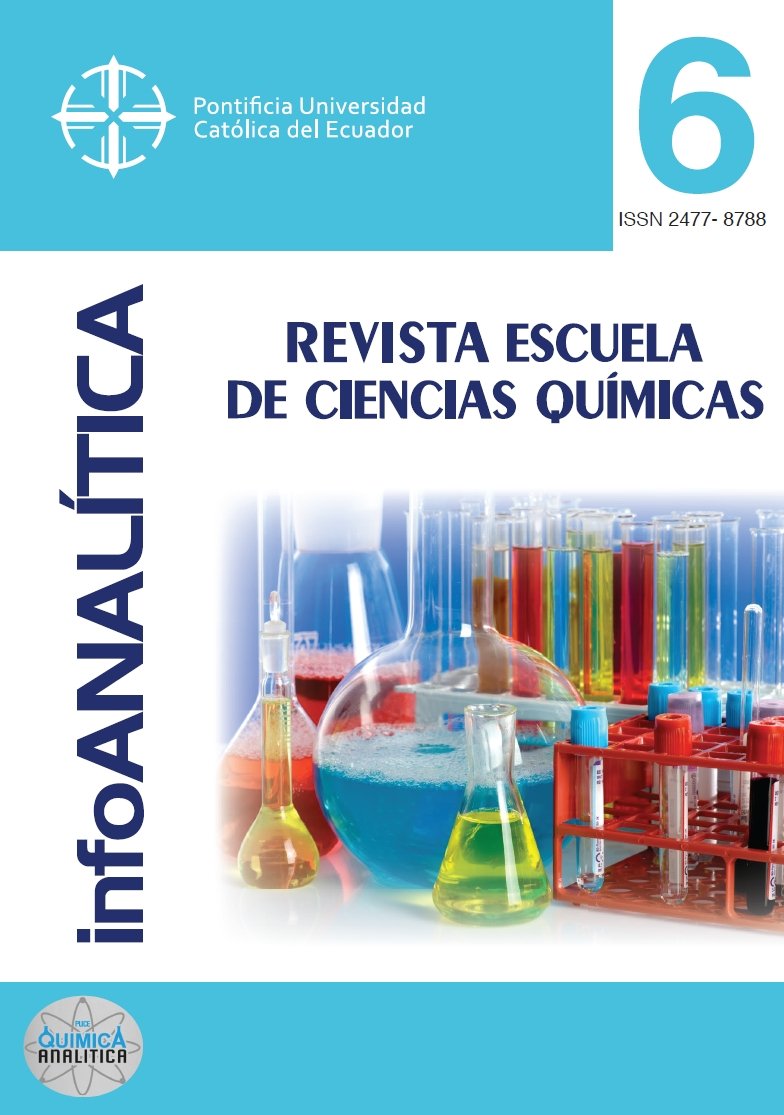Determination of BTEX in ambient air of Distrito Metropolitano de Quito by gas chromatography with flame ionization detector
Main Article Content
Abstract
The environmental contamination can be natural or anthropogenic, so this can cause the presence of certain substances that may affect health and comfort of habitants. Because of this, Benzene, Toluene, Ethylbenzene, m/p -Xylene and o- Xylene was analyzed in the air of Distrito Metropolitano de Quito (DMQ). In Quito these compounds are present in car fuel, so the pollution sources and period of contamination can be identified and controlled, causing a reduction in the environmental impact. The determination of these compounds was done by passive sampling and then ultrasonic extraction using hexane as solvent for the further analysis in gas chromatography with flame ionization detector. The separation, identification and quantification of the compounds were possible because of the chromatography conditions that were used. BTEX was monitored in 43 places along DMQ, with a period of exposition of 30 days. The mean annual concentration obtained for benzene during October 2016 to January 2017 was 0,07 – 13,85 μ g/m 3 , value that exceed the environmental regulation established by the European Commission, 5 μ g/m 3 . The concentration of BTEX have been in- creasing in 2017 compared to previous years because of vehicular congestions as well as the use of fuel in festivities of December 2016 and January 2017.
Downloads
Article Details
- The authors agree to respect the academic information of other authors, and to assign the copyrights to the journal infoANALÍTICA, so that the article can be edited, published and distributed.
- The content of the scientific articles and the publications that appear in the journal is the exclusive responsibility of their authors. The distribution of the articles published in the infoANALÍTICA Journal is done under a Creative Commons Reconocimiento-CompartirIgual 4.0 Internacional License.
References
Agencia de Protección Ambiental de los Estados Unidos de Norteamérica (EPA). (2016). TRI-Listed Chemicals Toxics Release Inventory (TRI) Program. Recuperado de: https://www.epa.gov/toxics-release-inventory-tri-program/tri-listed-chemicals
Comisión Europea (2016). Air Quality Standards. Recuperado de: http://ec.europa.eu/environment/air/quality/standards.htm
Delgado, J. (2005). Validación e implementación de técnicas de captación pasiva para el estudio de los niveles y efectos de ozono troposférico y dióxido de nitrógeno en un área costera mediterránea (Disertación de doctorado). Universitat Jaume I, Castellón de la Plana, España.
Instituto Nacional de Seguridad e Higiene en el Trabajo. (2013) Compuestos orgánicos volátiles: determinación por captación en tubos multilecho y análisis DT-CG-EM. Recuperado de http://upcommons.upc.edu/bitstream/handle/2117/21016/ntp978.pdf
Marcillo, A. (2010). Desarrollo de una técnica de muestreo pasivo y análisis por HPLC (UV-VIS) para la determinación de aldehídos en aire del Distrito Metropolitano de Quito (Disertación de pregrado). Pontificia Universidad Católica del Ecuador, Quito, Ecuador.
Ramírez, V. (2012). Cuantificación de compuestos aromáticos (BTEX) en las emisiones gaseosas de fuentes móviles terrestres de gasolina en el Distrito Metropolitano de Quito (Disertación de pregrado). Universidad Central del Ecuador, Quito, Ecuador.
Sánchez, J. y Alcántara, A. (2008). Compuestos orgánicos volátiles en el medio ambiente. Madrid.
Secretaría de Medio Ambiente, Recursos Naturales y Pesca. (1998). Norma Oficial Mexicana NOM-123-ECOL-1998, que establece el contenido máximo permisible de compuestos orgánicos volátiles (COVs), en la fabricación de pinturas de secado al aire base disolvente para uso doméstico y los procedimientos para la determinación del contenido de los mismos en pinturas y recubrimientos. Recuperado de http://www.profepa.gob.mx/innovaportal/file/1282/1/nom-123-semarnat-1998.pdf
Vernier, J. (1998). El medio Ambiente. México: Publicaciones Cruz O., S.A.

